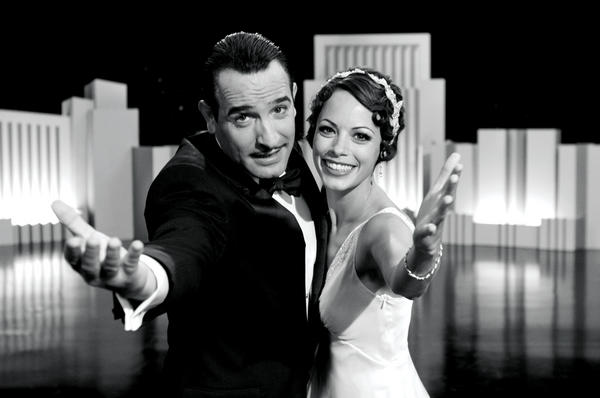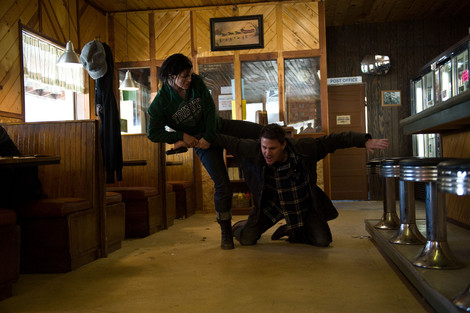by Raj Ranade
First off: if you’ve never seen a silent movie (which I suspect is true for a lot of people reading), head to the Kentucky Theatre straight away and give The Artist a chance. There’s a perception that silent movies are musty art-house relics that can’t connect with modern audiences – a perception that The Artist is expressly designed to demolish. This crowd-pleasing story of a silent movie star transitioning into a talky new Hollywood is practically pharmaceutical in its attempt to shoot straight to the pleasure centers of your brain. And silent cinema in general is a wholly different and fascinating beast from sound film – you’ll be impressed by how much filmmakers can convey with a minimum of words, and stunned at how lazy modern filmmakers leaning on sound can be. Finally, you’ll want to be in the know about the clear front-runner for Best Picture at the Oscars. So go! Have one of those new bourbon cocktails from their concession stand! Enjoy!
Back? If you’re like me, you remain impressed by the film’s gushing charm and frothy humor – and somewhat baffled that this is the Best Picture front-runner. I don’t want to undersell how irresistible this film can be at times. Jean Dujardin, as the star sinking into obscurity because of his refusal to speak on film, has the light grace and easy humor of a Gene Kelly (the movie is essentially a silent remake of his Singin’ in the Rain), and he has tremendous chemistry with co-star Berenice Bejo, the ingenue rising as her Hollywood crush is falling. A remarkably well-trained Jack Russell Terrier also arguably outperforms them both and makes The Artist the most effective puppy commercial since Marley & Me. And director Michel Hazanavicius has a wonderful light touch for sight gags, musical numbers, and the occasional smart lo-fi special effect – like the film’s peak, where Hazanavicius breaks a few of the rules he has set out for himself in this project.
But the fact that I’m citing an adorable puppy as a key virtue of the film should indicate that the irresistibility here is of a lowest-common-denominator kind, leaning hard on the cute and cuddly. That’s not always a bad thing, but it grates when a feather-light farce starts trying to wring tears out of you. When the film sinks into a maudlin mode towards its climax, it feels forced (and film buffs will be particularly annoyed by Hazanavicius’ attempt to invest unearned gravity into his story by stealing the score of a Hitchcock classic). And even though the film’s ultimate goal is to bring silent movies to a new audience, it ends up doing silent cinema a disservice by depicting it as rather simplistic (Charlie Chaplin’s slapstick was delightful, but his films were also whip-smart commentaries about the society he lived in).
It’s not a spoiler to say that The Artist ends with a dance number, and as fun as that closing scene is, it also unintentionally illustrates the film’s key problem. Right after the dancers have finished, sound breaks in and we hear the dancers breathing heavily. It’s a symbol of a film that always seems like it’s straining for your approval. It ultimately may earn it, but we see it sweating. Chaplin, Keaton, Astaire and Rogers – they made it look easy.
Mixed-martial-arts fighter Gina Carano, as you might expect, cannot really act. It’s a good thing that she doesn’t really have to in Steven Soderbergh’s Haywire. Soderbergh’s action thriller is less interested in dramatic truth than in the truth of body slams, backflips, and broken noses. As a great philosopher once said, hips don’t lie – and neither do knees, elbows, feet, or fists.
There’s a plot to Haywire, involving a government assassin (Carano) double-crossed by one or several of her fellow cloak-and-dagger types (potentially including Ewan McGregor, Michael Fassbender, Antonio Banderas, and Channing Tatum). None of this, however, is particularly important (in case that kind of thing is a deal-breaker for you). The purpose of this film, as with the no-budget Asian martial arts pictures it often resembles, is to present a catalog of the preternatural talents of its star: she runs! she wall-kicks and somersaults! she crushes a man’s windpipe between her toned thighs!
Carano does all her own stunts here, which leads to fight scenes with the kind of fakery-free visceral brutality rare to CGI-airbrushed modern cinema (her hotel-room fight with Fassbender is one for the ages). That’s impressive enough, as is the fact that she quite credibly dismantles men that are twice her size, but the reason that Carano is a star to watch in the future is her arresting stage presence (even if I doubt that she’d be very good at emoting – I suspect that vulnerability, for example, is a relatively foreign concept for her). She’s incredibly intimidating in this film, and not just because of her physical strength – muscleheads are a dime a doped-up dozen – but because she seems to have a special kind of fighter’s intelligence. She’s less a brute-force Mike Tyson than a quick-thinking Muhammad Ali – when she moves and strikes, you sense her strategizing and probing for weakness on the fly, an abiding thoughtfulness behind her every move.
If there’s any man in this film that she does have trouble with, it’s Steven Soderbergh. Haywire seems like a reaction to the jittery Bourne-style aesthetic so dominant in modern Hollywood – Soderbergh instead opts for long, still shots of his heroine’s acrobatics. In action and chase scenes, this works extremely well – it allows for a full appreciation of the intricate fight choreography involved and also sets up some nice jolts that are a result of our trapped perspective (like an unexpected intrusion into our heroine’s car during a chase).
But the stillness extends through to the rest of the movie too – there’s a dead-air quality to the obligatory plot explanations and arty pauses between the film’s adrenaline shots. With the other actors, it seems like Soderbergh is reluctantly fulfilling his obligation to give the major movie stars something to do, when all he really wants is to have Ms. Carano fling them into the nearest available metal surface. (You wonder what caused Soderbergh’s recent vendetta with movie stars – you may recall that in last year’s Contagion, he not only kills off Gwyneth Paltrow with a super-virus within the film’s first ten minutes, but also gives her a loving close-up as doctors bore into her skull during the autopsy). Still, awkward pacing can’t sink a star turn this impressive, and I hope Ms. Carano has a long career of beating up assorted famous people ahead of her.










